10 Apr 2021 - {{hitsCtrl.values.hits}}
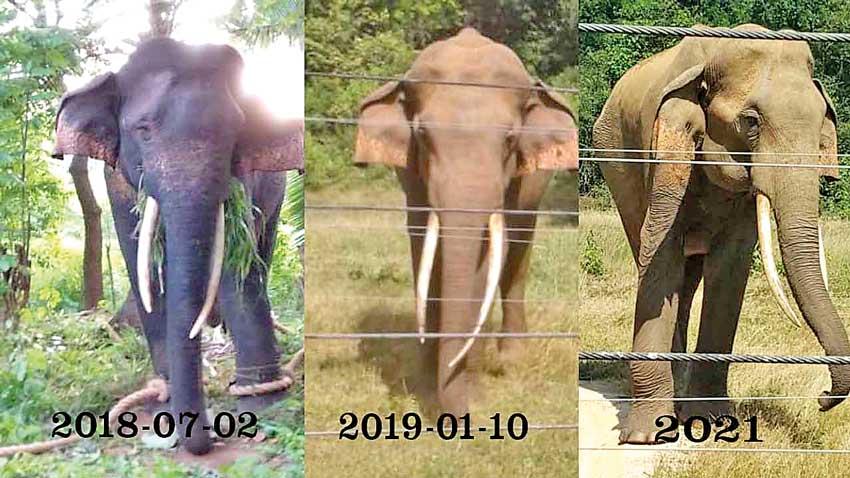
Elephants in captivity might be underfed and living miserable lives
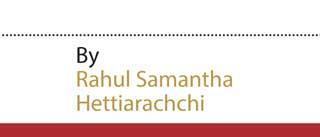 The human-elephant conflict in Sri Lanka has gathered momentum in proportions not seen earlier and available reports indicate that out of a population of 6000 Wild Elephants-recorded between 2014 until March 2021- Sri Lanka has lost 2087 Elephants and nearly 550 human lives.The most number of loses in Elephants and human lives was reported in 2019 and the figures read as 415 elephants and 115 humans. The number of elephants getting killed and the number of human lives lost is ever increasing with the conflict becoming tense. Environmentalists cite the reason for this situation the clearance of forest land where the wild elephants habitats exist.
The human-elephant conflict in Sri Lanka has gathered momentum in proportions not seen earlier and available reports indicate that out of a population of 6000 Wild Elephants-recorded between 2014 until March 2021- Sri Lanka has lost 2087 Elephants and nearly 550 human lives.The most number of loses in Elephants and human lives was reported in 2019 and the figures read as 415 elephants and 115 humans. The number of elephants getting killed and the number of human lives lost is ever increasing with the conflict becoming tense. Environmentalists cite the reason for this situation the clearance of forest land where the wild elephants habitats exist.
The human- elephant conflict should be dealt with scientifically with an approach safeguarding elephant habitats and assuring they have easy access to food, protection of sources of requirement like water and maintaining environmental balance. It is regrettable to note that overlooking all these scientific methodologies, haphazard systems like relocating them and limiting these animals to a segregated area are now being considered as a solution to this national issue. The Horowpothana Elephant Transit Home is a typical example in this regard.
This transit home which was specially setup as an answer to resolve the human- elephant conflict has now proved to be a failure. It appears to be a torture chamber for these animals, critics pointing out that it’s a prison for them. This investigation is done to draw public attention further in this regard.
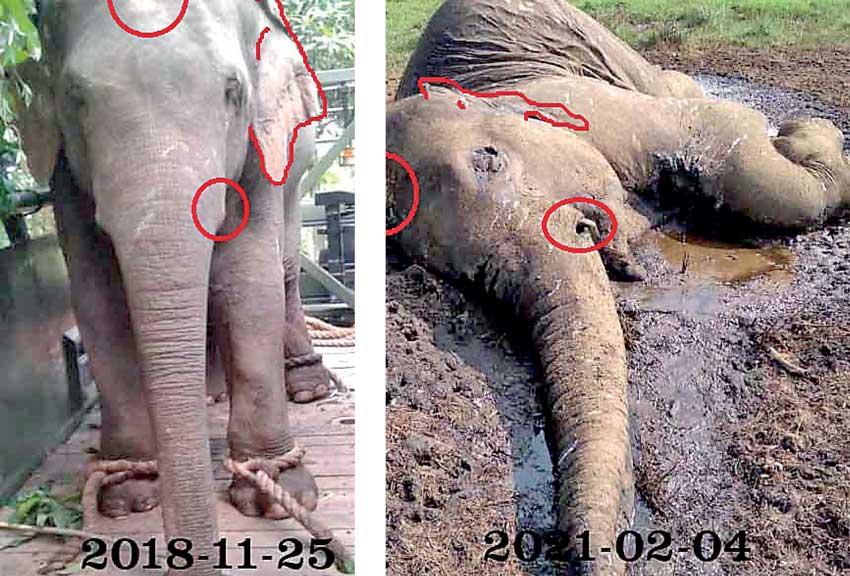
The Prime Minister of the Yahapalanaya Government Ranil Wickremesinghe in 2019 and the Minister of Wild Life S.M. Chandrasena had expressed their views on this Elephant Transit Home stating that this facility functions as a rehabilitation centre for wild elephants captured.
“Arrangements are now being made to construct a centre in Horowpothana to detain the captured wild elephants and rehabilitate them”(ITN News Editor September 04 2019 15.01-Linkhttps//www.itnnews.lk/2019/09/04/17041).
Minister Chandrasena had further stated during a Live@8 Rupavahini news telecast onDecember 12, 2019 that this centre is purely a place of caring and nourishing for the destructive wild elephants. “The captured fierce elephants would be brought to this place. Ponds had been constructed with sufficient water for the animals. There are also arrangements in place to provide food during scarcities. It is also expected to have this centre open for both local and foreign tourists” (News link-https//www.youtube.com/watchtv=CuO9uhsmUI)
Corrupt officials
Contrary to what the authorities opine about this centre critics point out that instead of caring for the animals funds allocated to provide food and nourishment for the detained animals monies had been siphoned off by corrupt officials hand in glove with contractors in self-nourishment. Details of these corrupt practices have now come to light.
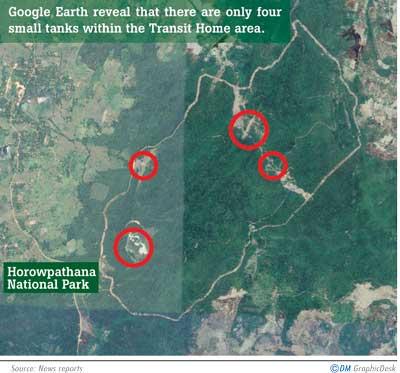 The failure of this centre and the large scale fraudulent financial transactions that had taken place there are now revealed in a report dated October 2020 under heading IEN/F/DWC/19/PR/11 issued by the Auditor General W.P.C. Wickramarathne. The Auditor General states further that due to these fraudulent activities the purpose of setting up this centre could not be achieved.
The failure of this centre and the large scale fraudulent financial transactions that had taken place there are now revealed in a report dated October 2020 under heading IEN/F/DWC/19/PR/11 issued by the Auditor General W.P.C. Wickramarathne. The Auditor General states further that due to these fraudulent activities the purpose of setting up this centre could not be achieved.
This report had also revealed in addition that large scale fraudulent activities had taken place when setting up this centre. The first in this instance was the construction on a land, with an extent of 997 Hectares, where Rs 345 Million was spent following the Cabinet paper number 12/0151/549/001 dated 17/3/2012 without obtaining the report on the Environmental Impact of the project.
The Auditor General’s report indicates that the first Elephant was released to this centre on September 4, 2015 and the last Elephant has been released in February 2021. During this period 64 elephants had been released to this centre as revealed by information obtained from the Wild Life Conservation Department under the Right to Information Bill.
 The Auditor General states further that due to these fraudulent activities the purpose of setting up this centre could not be achieved The Auditor General states further that due to these fraudulent activities the purpose of setting up this centre could not be achieved |
| - - - - - - - - - - - - - - - - - - - - - - - - - - |
 Skeletal remains of six wild elephants, who had died in this manner, had been discovered in December 2017 during construction work of an internal roadway within the Horowpothana sanctuary Skeletal remains of six wild elephants, who had died in this manner, had been discovered in December 2017 during construction work of an internal roadway within the Horowpothana sanctuary |
|
-Asian Elephant Expert Dr Pruthiviraj Fernando
|
An official of the Department of Wild Life Conservation (DWLC) - who preferred to remain anonymous- said that the nutrition provided to the 20 remaining elephants at this centre too is below average. This is due to the deprivation of even the scanty meal provided from outside sources. There is a requirement that a minimum of 44 elephants should be present at the transit home, but due to the non availability of records pertaining to these animals at the DWLC information could only be obtained under the provisions of the Right to Information Bill. This position had been further confirmed by the Auditor’s reports. Twelve Elephants had died after having gone missing in this manner. Five of them had died due to malnutrition caused by scarcity of food as detailed in the audit report. But a probe by this newspaper revealed that 15 wild elephants had died at the transit home.
Elephants gone missing
Though the DWLC had said that elephants have gone missing from the transit home, what had happened is that many had died and others had escaped after breaching the electric fence erected within the Elephant Kraal.
“Elephants kept at the transit home have no food, therefore they some or the other breach the electric fence and escape, and we have seen them on several occasions. An animal straying like this would then intrude into the villages and pose a threat to their lives and often damage crops. The elephants who intrude into the villages are often shot at and killed by farmers” said B.K. Siriwardene a resident of Horowpothana.
Our inquiries regarding the number of elephants who had died at the transit home were answered thanks to the Right to Information Bill. It was revealed that the department had not made any survey on the number of elephants who had died.
Despite the unresponsiveness of the DWLC our surveys uncovered that several autopsies have been conducted on the dead animals by the wild life veterinarian in charge of the zone Dr Chandana Jayasinghe who was assisted by wildlife officials.
As laid down under clause number 10 of the Animal welfare and Etiquettes guidelines issued by the Worlds Animal and Aquarium Organisation, when releasing an animal from a zoological garden to a forest, the training in adapting the animal to the new environment has to be done gradually. But by violating such principles of etiquette two Elephants from the Pinnawala Orphanage, coming under the purview of the National Zoological Gardens, had been released to the Transit Home. One of the elephants named Jayathu had died due to malnutrition and no reports are available to ascertain whether the other elephant had escaped or died.
With the use of 58% of the land at Horowpothana National Park to set up the Elephant Transit Home the other animal population had been deprived of their habitats and sources of food. When the erection of electric fences around the Transit Home took place it was the duty of the department to remove those animals that would have got trapped within those areas. However a water buffalo and a she elephant remains within this restricted area unnoticed by the authorities. An officer of the DWLC, who claimed anonymity, said that the grasslands becoming scarce and the few available becoming parched had caused the deaths of many elephants; deaths happening due to starvation and hunger. This was proved during our observation tours.
Ponds with the capacity of 2000 litres were constructed, but the absence of water in them and the lack of bowsers at the Transit Home were also observed and though there being necessities the Transit Home lacks these facilities; a fact stated in the audit report.
|
- DWLC Director General Chandana Sooriyanandara
|
Animals ‘imprisoned’
A fully grown elephant generally walks about 20-25 Kilometres a day, while an elephant in rut walks about 60 Kilometres a day as stated by environmentalists. But the acreage in the Horowpothana Elephant Transit Home is around 998 Hectares or 2466 acres which is considered too small an area for elephants to move about.
It is necessary that a wild elephant needs around 200-300 Kilograms of food as confirmed by Dr Prithiviraj Fernando, a researcher of Wild Elephants. It is not possible to obtain this amount of food from plants and herbs within the area of the Transit Home as it is located in a forest area having secondary features. In a similar situation it is necessary to obtain food from elsewhere. With the suspension of the supply of such food the elephants are facing the challenge of food scarcity. Therefore ‘the home’ has now become a prison for these creatures where they are actually tortured because food and water are limited.
The picture of the elephant published (picture 01) is a classic example of the food scarcity at the Horowpothana Transit Home. The animal had been captured in Cementigama in Puttalam at the age of 30 years and the height of the animal had been 8 Ft 6 in (8’6”). This animal had been moved onto the Horowpothana on July 3, 2018. By 2021 this elephant should have been a fully grown to be a healthy animal of 33 years. But the photo reveals a different picture of an elephant who has undergone much misery. A contract to supply food for 32 elephants at the Horowpothana Elephant Transit Home for the period November 1, 2018 to October 31, 2019 to the value of Rs 26,133,700 had been awarded. Neither tests about the quality of the food nor consideration about whether the elephants would prefer their taste had been done. No proper evaluation too had been done, the relevant audit report reveals.
The investigations done by this newspaper led to the conclusion that the contract for the supply of food had been obtained by one Nissanka and his close alliance with an official of the Wild Life Department had facilitated the transaction.
A person claiming anonymity declared, “I too was involved in this supply of food. What Nissanka does is the food that is given to the elephants is purposely weighed low and after taking it inside it is brought back and taken back in as a new supply. Nissanka was aided and abetted by an official of the relevant division”.
The supply of tamarind leaves, which the elephants do not eat, and the leftover of Jack leaves remaining without being eaten by the elephants are ample proof for the racket that’s taking place. What’s most surprising is that there had been no weighing scale at the site to weigh the food items that were brought from outside. Payments had been made without ascertaining the accurate weight of the food. There had been no officer delegated with the function of supervising the food for elephants. By June 2019 there had been only 9 elephants at the Transit Home and the records available show that the supply of food was made to 30 elephants from August 1, 2019 to 31st October 31. The audit report states that Rs 6,559,245 had been spent for the supply of food. No follow up action on the amount of food supplied and whether the food was properly provided to the animals had been done.
Therefore it is necessary that inquiries be conducted to unearth who had played out funds from the elephant feed.
When these matters were posed to the DWLC Director General Chandana Sooriyanandara, he opined, “there is no truth in the food shortage as expressed by some. The audit report had been compiled without a complete knowledge,”.
 Elephants kept at the transit home have no food, therefore they some or the other breach the electric fence and escape, and we have seen them on several occasions. An animal straying like this would then intrude into the villages and pose a threat to our lives and often damage crops. The elephants who intrude into the villages are often shot at and killed by farmers”
Elephants kept at the transit home have no food, therefore they some or the other breach the electric fence and escape, and we have seen them on several occasions. An animal straying like this would then intrude into the villages and pose a threat to our lives and often damage crops. The elephants who intrude into the villages are often shot at and killed by farmers”
- B.K. Siriwardene (Resident Horowpothana)
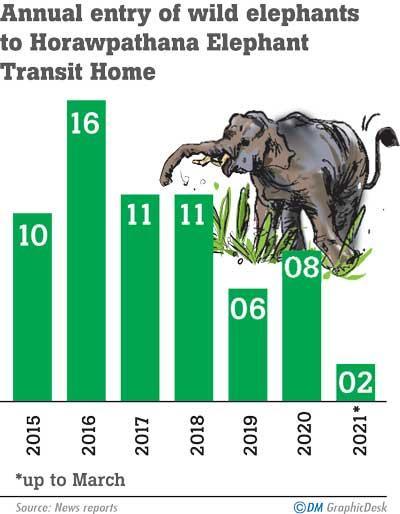 Despite the comments made by the Director General with regard to the findings in the audit report it is pertinent to mention that the audit had been done in accordance with the provisions of the Constitution of the Democratic Socialist Republic of Sri Lanka; the regulations embodied in the 19 National Audit Act of 2018 clause number3(1) A 5.(2) 12. This position had been clearly stated even in the relevant audit report. In the light of the above a situation the audit report being ridiculed is a serious issue.
Despite the comments made by the Director General with regard to the findings in the audit report it is pertinent to mention that the audit had been done in accordance with the provisions of the Constitution of the Democratic Socialist Republic of Sri Lanka; the regulations embodied in the 19 National Audit Act of 2018 clause number3(1) A 5.(2) 12. This position had been clearly stated even in the relevant audit report. In the light of the above a situation the audit report being ridiculed is a serious issue.
“Fierce elephants are very energetic males. By forcibly confining them to certain barricaded areas they lose the opportunity of mating with female elephants. This has directly impacted upon the elephant population from increasing. And this would also prevent a genetic growth of a generation of healthy and robust elephants. We may very soon lose these animals who once majestically wandered through our forest lands over many centuries,” Asian Elephant expert Dr Prithiviraj Fernando declared.
“Just capturing the elephants and imprisoning them in Horowpothana is not going to resolve this issue. If it is a success there cannot be deaths of 300 to 400 elephants annually. The elephants who are attacked by humans become violent and they attack in retaliation. Therefore first and foremost we should identify them, but it is a pity that no proper plan is in place. It is true that the fierce elephants are caged in this manner. It is similar to confining someone who has done wrong within a prison. When someone escapes from a prison or dies action is instituted against those who were in charge, but at the Horowpothana Elephant Transit Home when an Elephant dies or goes missing no one takes responsibility. This is a serious issue. At least a collar should be fixed on these animals by which their movements could be traced to some extent. What we have lost are animals that could have lived for another 20 or 30 years,” Dr Fernando added.
From these revealings it is proved beyond doubt that moving elephants in large numbers to a limited space at Horowpothana and non provision of sufficient food and water had caused severe malnutrition among the animals. The weak succumb to ill health caused due to starvation, while the robust and the strong breach the electric fences and venture out seeking food and water in villages; posing a great threat to lives and property and are frequently challenged by the farmers who kill these intruders. Should we see the continuation of this process? The elephants have lived with our people for centuries. They have adorned festivals and roamed through jungles; most of the time enjoying the pleasures of nature. Many have been eager to watch their movements which are fascinating. Many have visited this country to watch elephants crossing the roads in large groups. In the wilderness these animals can be seen or studied with no danger to visiters. Let us stand together and protect this creature; a pride of the nation.
Courtesy Ada Newspaper
27 Nov 2024 9 minute ago
27 Nov 2024 16 minute ago
27 Nov 2024 57 minute ago
27 Nov 2024 3 hours ago
26 Nov 2024 26 Nov 2024